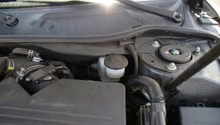Toyota Camry: Why Does My Brake Pedal Feel Soft?
Is your brake pedal a bit too soft? There are a few reasons as to what can be causing your brake pedals to lose pressure in the Toyota Camry.
This article applies to the Toyota Camry 4th, 5th, and 6th Generation (1997-Present).
Anyone who's experienced soft-braking power will be the first to tell you how terrifying it can be. The braking system on most modern vehicles is comprised of a hydraulic pump, which uses brake fluid to help compress the calipers and stop the Toyota Camry. When the car is off, the brakes can still work, but you will need to exert an extra amount of force to make up the difference from the absence of the pump itself. However, if you are experiencing a soft pedal, the usual culprit is air that has somehow entered the system. So the next question is how does the air get there? Well, we hope to help you answer that with the following tips listed below. Here's how to diagnose a soft brake pedal.

Materials Needed
- Brake bleed kit
- Jack and jack stands
- Tire iron
- Metric socket set
Step 1 – Bleed and adjust your rear brakes
The rear brakes may have air in them.
If your vehicle has drum brakes, those lines may be leaking. You are going to need to raise the vehicle, secure it, remove each wheel, and check the assembly.
- Visually inspect for any leaks.
- If any lines are leaking fluid, replace them. Some people prefer to think ahead and use stainless steel-braided lines to avoid any other instances of the line leaking again.
- Use a bleeder kit and remove any air that was caught in the system.
- Take a brake adjustment tool and adjust the brake shoes until the wheels firmly stop.
- Make sure to balance the braking power between the two rear brakes.

Related Articles
- How to Jack Up Your Car - CamryForums.com
- How to Flush Your Brakes - CamryForums.com
- How to Clean/Adjust Rear Brakes - CamryForums.com
Step 2 – Bleed your front brakes
Your front brake lines may have air.
Your front brakes make up roughly 80 percent of the braking power in your car. If you have any air in the system, the pedal will feel soft.
- Raise the vehicle and secure it.
- Remove the front wheels and inspect each brake line.
- If the brake lines themselves are leaking, replace them.
- Locate the bleeder screw on the caliper and begin bleeding the system.
- Continue to bleed it until air bubbles stop coming out.
Turn the car on and check the brake pedal pressure. If it's still soft, then you still have a leak somewhere in the system.

Pro Tip
Bleeding usually requires two people. However, brake bleeding kits are available, so all you have to do is keep checking and refilling the reservoir as gravity does most of the work.
Step 3 – Check the master cylinder
The master cylinder may have failed.
First, just as you're done with the front and rear brakes, bleed the master cylinder. This is to ensure there is no air in the system. After bleeding the master cylinder, proceed to check the brake pedal. If it still is soft, then you will have to replace the master cylinder and bleed all the brake components again.

Related Discussions
- 2000 Camry LE Soft Brake Pedal - CamryForums.com
- 05' Toyota Camry: FRONT BRAKES - CamryForums.com
- 2006 Toyota Camry Brakes - CamryForums.com






